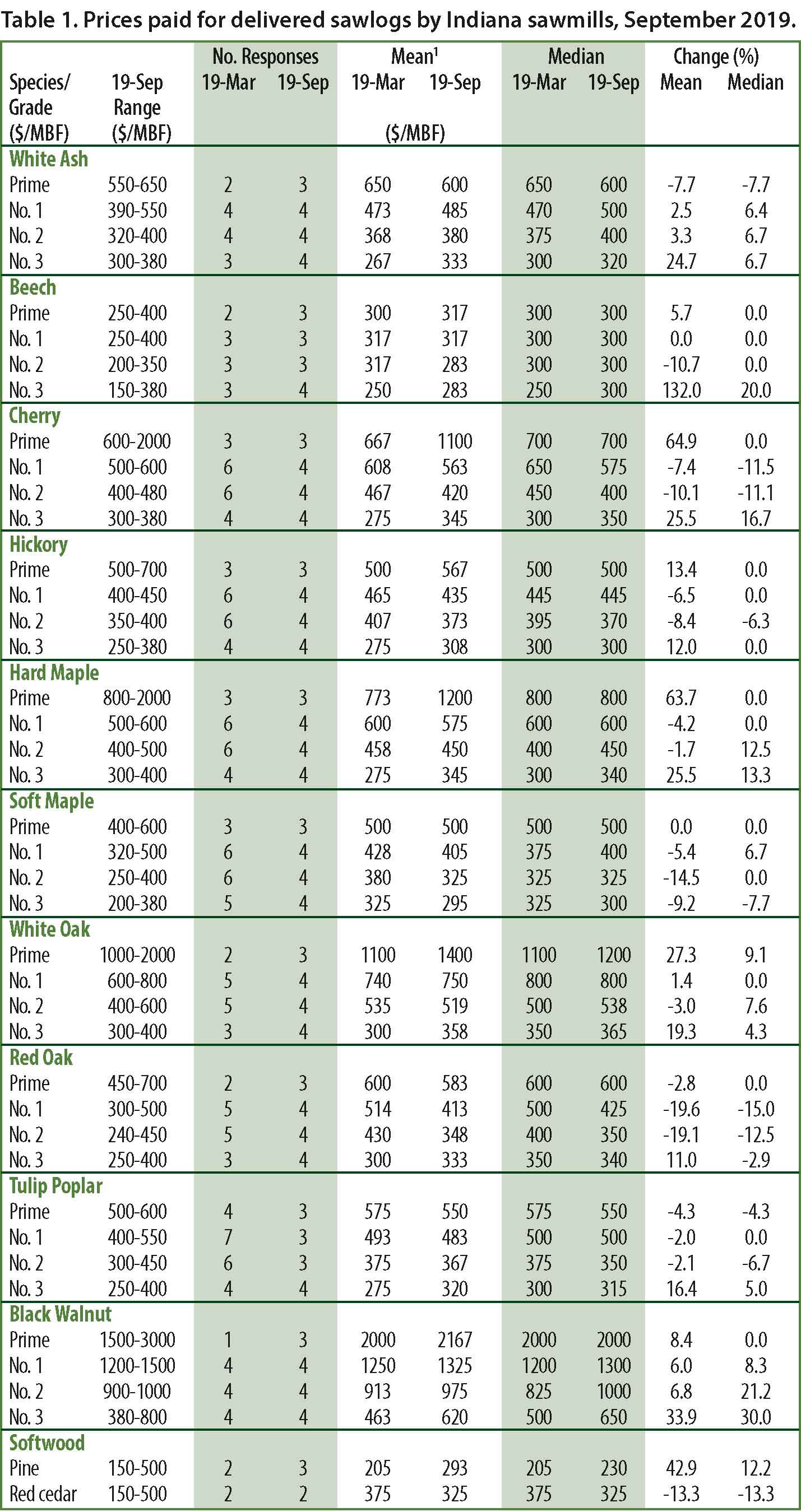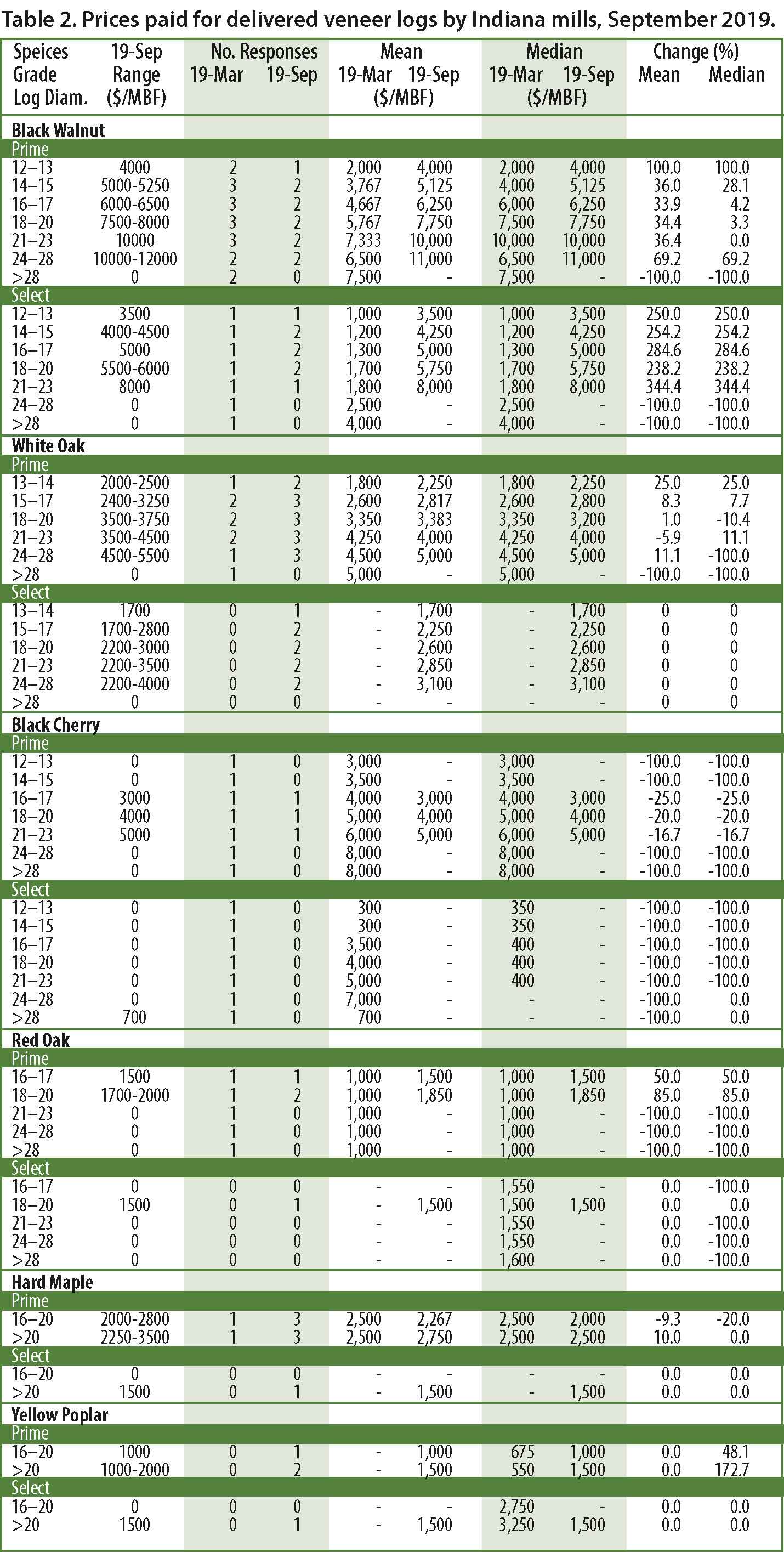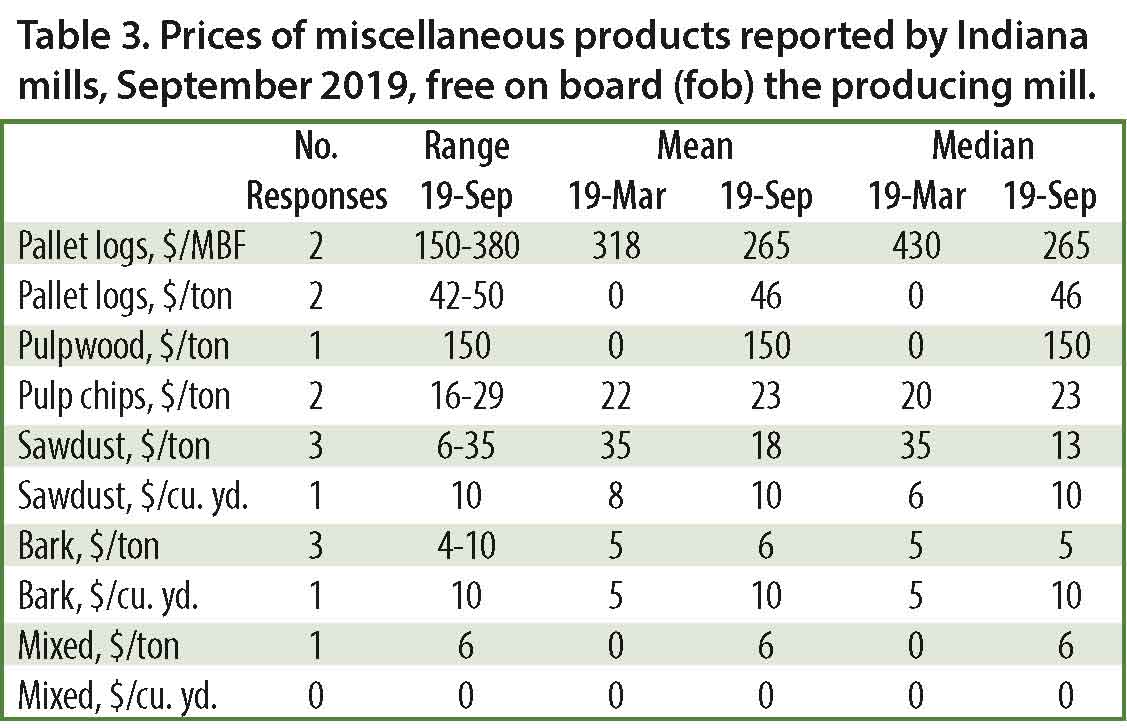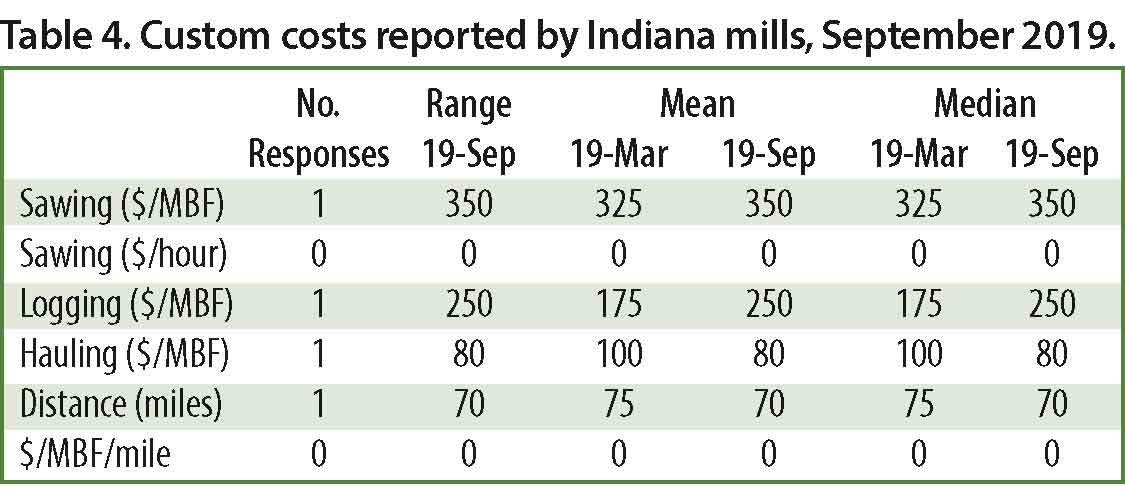2019 Indiana Forest Products Price Report and Trend Analysis
Survey Procedures and Response
Data is collected twice a year, but log prices change constantly. Standard appraisal techniques by those familiar with local market conditions should be used to obtain estimates of current market values for stands of timber or lots of logs. Please note, because of the small number of mills reporting logging costs, “stumpage prices” estimated by deducting the average logging and hauling costs (Table 4) from delivered log prices must be interpreted with extreme caution and are meant to only serve as a guide. Actual stumpage values you may be offered depend on many variables such as access, terrain, time of year, etc.
Data for this survey was obtained by a combination direct mail/email survey of a variety of forest product industries, including sawmills, veneer mills, concentration yards, and independent log buyers. Only firms operating in Indiana were included. The survey was conducted and analyzed by the Indiana Division of Forestry. The prices reported are for logs delivered to the log yards of the reporting mills or concentration yards. Thus, prices reported may include logs shipped in from other states (e.g., black cherry veneer logs from Pennsylvania and New York).
The survey was mailed to 17 firms and emailed to 32 firms. It is estimated these companies produce close to 90% of the state’s roundwood production. Electronic reminders, follow-up phone calls and additional mailings encouraged responses.
Ten firms reported some useful data. Three mills reported producing 1 million board feet (MMBF) or more. One mill reported production of 5 MMBF or greater. Total board foot production reported for 2018 was 25 MMBF compared to 36 MMBF for 2017, and 70 MMBF for 2016. The largest single mill production reported was 20 MMBF. These annual levels are not comparable since they do not represent a statistical estimate of total production.
The price statistics by species and grade don’t include data from small custom mills, because most do not purchase logs, or they pay a fixed price for all species and grades of pallet-grade logs. They are, however, the primary source of data on the cost of custom sawing and pallet logs. The custom sawing costs reported in Table 4 do not reflect the operating cost of large mills.
This report can be used as an indication of price trends for logs of defined species and qualities. It should not be used for the appraisal of logs or standing timber (stumpage). Stumpage price averages are reported by the Indiana Association of Consulting Foresters in the Indiana Woodland Steward, http://www.inwoodlands.org/.
Delivered Sawlog Prices
Ten mills reported delivered sawlog prices for the 2019 fall report. This is same number of mills that reported data from last fall’s report. Sawlog prices for the premium species (specifically black walnut and white oak) were higher than what was reported in the 2019 spring report.
Hardwood Species
Black walnut prices were up for all sawlog grades by an average of almost 14% (Table 1). Sawlog grades of prime and #3 had the biggest increases of 8% and 34%, respectively. White oak sawlog prices were also higher than the spring report. Overall, prices were 11% higher. Prime sawlog prices were up 27%, and #3 grade sawlogs were up 19%. White oak sawlog prices had an increase of almost 11%. From an overall standpoint, prices were higher than what was reported in the spring 2019 report. Ash sawlog prices were up almost 6%, hickory prices were only up 3%, hard maple sawlog prices were up almost 21%, tulip poplar prices up 2%, and cherry prices were up 18% but caution should be taken because demand for cherry is sluggish. Grades 1-3 were up 3%. Although demand for soft maple is decent and markets are good, sawlog prices were down 7% from the spring report. Red oak sawlog prices were off 8% compared to March 2019 figures. Red oak was a large percentage of the total volumes sent to China, so the tariffs have hit this species especially hard. Several in the industry have commented that one can hardly give away red oak. Please note the price information is meant to be used only as a guide. Several variables can have significant impacts on pricing data, such as number of responses, access to timber, topography, diesel fuel costs, and closeout costs.
Softwood Logs
Price data for softwood (pine and cedar) should also be looked at with caution as only five mills reported data. Pine sawlog prices were up significantly at 43%, and red cedar prices were off by 13%.
Veneer Log Prices
The number of mills reporting veneer log prices continues to be a problem. Depending on species, there were between 1-3 mills reporting (Table 2). This is a concern as far as how accurate of a picture the data presents. Please keep this in mind as you view the results below. The limited number of responses is an important key to remember. This report should serve only as a guide rather than “the rule”. Prices were reported by both veneer mills and sawmills. Sawmills resell their veneer-quality logs to veneer mills, exporters, overseas importers and manufacturers. On occasion, sawmills may produce specialty cuts like quarter sawn with the marginal veneer logs. The variation in veneer log pricing is due to the mix of veneer mills, sawmills and loggers reporting their values. This difference in values could be reduced if prices were only from veneer manufacturers.
Markets are mostly slower than what was reported in spring 2019. With a large volume of veneer logs being exported, the trade war/tariffs appear to be having significant impacts on the market. Early, many thought the tariff issues would be resolved sooner rather than later but that has not been the case. White oak veneer log prices were off by 10% compared to the spring report’s figure. Only data from prime veneer logs can be used for comparison due to no comparable data being reported for white oak select veneer logs in the spring report. The same concern surrounds walnut. Only one mill reported data for select grade walnut veneer logs, so comparing spring 2019 data to this fall’s report does not accurately portray the market conditions. For prime walnut veneer logs, prices were 30% higher compared to those in the spring report. Again, keep in mind that only two mills reported walnut veneer pricing.
Because there was only one mill reporting on three cherry veneer log diameters, we do not feel the data accurately represents the cherry veneer log market. However, we feel the veneer log is comparable to the cherry sawlog market, which is sluggish to very weak. Responses on red oak veneer closely resembled those for cherry. However, in red oak’s case, those few responses closely mirrored those from the spring report—there was less than 1% difference. Hard maple pricing data between prime and select veneer logs offset each other, with prime pricing data showing a 9% decrease and select showing a 10% increase. Due to no pricing data being received for yellow poplar in the spring report, we cannot draw an accurate conclusion in comparing the few responses received for this report.
Low Grade / Industrial Products
The change in prices paid for or received for various raw-wood products between the spring 2019 report and the current report are shown in Table 3. Raw-wood products are of lower quality, and sometimes smaller logs are purchased in batches of random species to be sawn into cants or chipped. The cants are re-sawn into boards used for pallets, blocking, railroad ties or other industrial applications that have a strong market. It is estimated that as much as 60% of the lumber produced goes into an industrial market. Some mills restrict purchases to specific species or exclude specific species, depending on the markets they sell to. The price for pallet and cant logs decreased by 20% from the 2019 spring report. Pallet manufacturers are consuming consistent volumes of pallet lumber and cants; however, supplies are plentiful, with only a few localized exceptions. Prices are declining in most areas. Tie-treating operations are readily absorbing all the crossties sawmills can produce. Some worry the market will become saturated, but there is no evidence of that happening yet. Price data for sawdust varied greatly from $6/ton to $35/ton. Bark prices were more than 20% higher than what was reported in the spring 2019 report. Coarse mill residue (chips) prices were 4% higher than in the 2019 spring price report.
Until about the 1970s, sawdust, chips and bark would have been burned or landfilled by many mills. Those materials now have many more uses. Sawdust can be used to make fuel pellets, burned as a heating source, or used as animal bedding. Wood chips are produced primarily from slabs sawn off of debarked logs. The decline in the pulp and paper industry is a threat to this market. Bark used for landscape mulch is now a large market. In some facilities, all or some portion of these byproducts is used to fire efficient low-emission boilers to heat dry kilns year-round and to heat facilities in the winter. Attempts have been made to cogenerate electricity at mills, stand-alone generating plants, and biofuel. Success has been limited by the low cost of electricity purchased off of the grid, below-cost price received if sold into the grid, the high cost to produce biofuels, and in many cases public opposition.
Custom Costs
Costs of custom services increased from the spring report in the area of sawing ($/MBF). The high cost of diesel fuel usually plays a large role in logging costs as well as sale layout and costs to close out sales implementing Best Management Practices (BMPs) (Table 4). Only one response was returned for logging costs, and it was reported at $250 MBF. Although this was the only reported figure, the cost is probably accurate. Custom sawing costs are normally associated with portable sawmills. For many years, the common rate was $250 MBF. The custom sawing cost reported was $350 MBF. The average distance was reported at 100 miles, which is likely accurate. In most cases it is difficult to remain profitable if mills reach out over 100 miles for their logs. Keep in mind, though, with all of the custom cost information, we only on response was received.
Jeffrey Settle is a Forest Resource Information specialist with the Indiana Division of Forestry. Chris Gonso is a Hardwoods Program Manager with the Indiana State Department of Agriculture.
